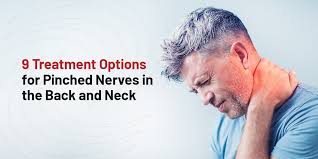
Usual pinched nerve in the neck symptoms? Cervical radiculopathy, commonly called a “pinched nerve,” occurs when a nerve in the neck is compressed or irritated where it branches away from the spinal cord. This may cause pain that radiates into the shoulder and/or arm, as well as muscle weakness and numbness. Cervical radiculopathy is often caused by “wear and tear” changes that occur in the spine as we age, such as arthritis. In younger people, it is most often caused by a sudden injury that results in a herniated disk. In some cases, however, there is no traumatic episode associated with the onset of symptoms. See extra info at pinched nerve.
In most cases, the pain of cervical radiculopathy starts at the neck and travels down the arm in the area served by the damaged nerve. This pain is usually described as burning or sharp. Certain neck movements—like extending or straining the neck or turning the head—may increase the pain. Other symptoms include: Tingling or the feeling of “pins and needles” in the fingers or hand Weakness in the muscles of the arm, shoulder, or hand Loss of sensation.
Pinched nerve in the neck natural remedy : The heat will relax the muscles that might be tight around a pinched nerve. Heat also increases blood flow, which can help the healing process. He suggests using a heating pad, which you’ll be able to find at your local drug store, or a warm compress. “Just as you should with ice, protect your skin from direct heat sources,” he says. “Don’t use uncomfortably hot heat, and avoid heat altogether if your skin is damaged or if you are already using a pain cream.” Hold heat directly onto the pinched nerve for 10 to 15 minutes at a time.
If a nerve is pinched for only a short time, there’s usually no permanent damage. Once the pressure is relieved, nerve function returns to normal. However, if the pressure continues, chronic pain and permanent nerve damage can occur. The following factors may increase your risk of experiencing a pinched nerve: Sex. Women are more likely to develop carpal tunnel syndrome, possibly due to having smaller carpal tunnels. Bone spurs. Trauma or a condition that causes bone thickening, such as osteoarthritis, can cause bone spurs. Bone spurs can stiffen the spine as well as narrow the space where your nerves travel, pinching nerves.
Invest in roller balls: Another option for people with wrist pain is roller balls, which are basically foam rollers for your tight arm muscles. (Prefer to shop online? See here and here). Using these as often as possible — ideally once every hour — can be therapeutic. Wear a wrist splint: For people with severe carpal tunnel syndrome, a splint can be beneficial. Why? Because it forces you to rest and protect your wrist. (Typically, wrist braces or supports aren’t recommended as an early treatment strategy.)
What is the cervical spine? Your spine (backbone) is the long, flexible column of bones that protects your spinal cord. It begins at the base of your skull and ends in your tailbone at your pelvis. Your cervical spine is the neck region of your spine. It consists of seven bones (C1-C7 vertebrae). Vertebrae help protect your spinal cord from injury. Between your vertebrae in your spine are round cushions called disks. They have soft, gel-like centers and a firmer outer layer, like a jelly doughnut. These disks provide cushioning for your vertebrae and flexibility for you.